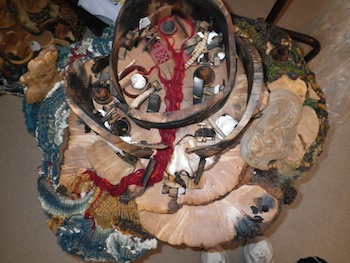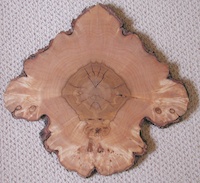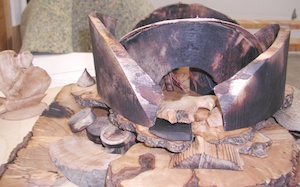| Odyssey | Spirit Caves | Mom's Bones | Tikkun Olam | Weaving | Totems |
Troy Destroyed:
Destruction of the Sacred City
.jpg)
10"h x 20"w x 26"d
Eucalyptus, birch, scorched sycamore, shells, ink, varnish, ashes, fabric, fiber

At the end of the Trojan War, three millennia ago, as Odysseus and other Greek leaders head for home, the Trojan core, the sacred city, lies in ruins, a burned-out shell.
Enter through this torn gateway, its lintel ripped apart by the Trojans to accept the Trojan Horse, supposedly a departure gift from the retreating Greeks. Follow the path inward, the stream of blood and fire, past Trojan Horse fallen now, severed from its wheels, scorched at the entry.

As the story goes:
By the tenth year of the Trojan War (in the biggest picture, a war for love), all that remains of the sacred city of Troy is a burned-out shell. Troy's ruling family and many inhabitants are dead, others enslaved, mere booty, with a few survivors on the run. From its inner heights and altars to the golden sands of its beaches, Troy, also known as Ilium (hence Homer’s Iliad,) is set aflame after the deluge of blood from both sides in this long war. Yet it is not so much a lack of strength that fells the powerful Hittite city. Rather a strategic gift from the enemy Greeks does the trick. Designed by the inventive Odysseus, the Trojan Horse is doubly treacherous. It is offered as a parting gift by the Greeks who pretend to sail away before the war actually ends. To accept the gift, to wheel the wooden horse inside the citadel, the Trojans must dismantle the limen, or upper beam of the main gate, breaching the magic defenses of the long-standing walls of Troy, built long before with divine aid, as the story goes, the foundations placed by the sea-god Poseidon (though the mortgage had not yet paid) and the walls raised by Apollo’s music. Yet if the Trojans refuse the gift, and so retain the integrity of their walls, then according to ancient custom, they would be violating the fundamental rules of engagement. There is a grace in accepting a gift, just as there is a violation implied in our expression, "to kick a gift horse in the mouth." Consider the persistence of image over time in our term for the secret breaching of an internet wall by sending in --- yes, a Trojan horse!
Hidden in the belly of the wooden horse are Greek warriors about to be birthed into the liminal realm of destruction and death the Trojans will suffer at their hands. However the Trojans, still celebrating the Greek plans to depart and still admiring the bridled, wheeled horse statue now within their sacred citadel, do not know what grief that cavernous gift conceals. Helen, the captive Greek beauty, walks the inner walls of Troy and whispers taunts at the men inside the belly of the horse. Whose side is she on, one might very well wonder! The armed Greeks emerge under cover of darkness. Some lay waste to the city, others open the city gates to the Greek army that has returned to encampments just beyond the walls and on the beaches near their ships. Finally defeating the Trojans, and extricating Helen, the Greek fleet prepares for the trip home.
Homer’s Odyssey relates the return journey of the Greek leader Odysseus to his home on Ithaca, an island west of Greece. Even after ten years away at war, in his mind’s eye Odysseus can still see the smoke of the hearth fire rising from the familiar chimney of home. Sailing from Troy with his men in twelve ships, Odysseus has two goals, to lead his men safely back from war and to reunite with his family. Smooth sailing, the journey should take only two weeks, including a few stops along the way for provisions.
Yet as Homer tells us in the Odyssey, it takes Odysseus another ten years to get home. He encounters many obstacles, even divine resistance. He also receives a great deal of help. He loses his twelve ships, his entire crew, and all the booty of war, yet the Greek goddess Athena and many other beings, both human and divine, guide him toward home, while one god, in particular, Poseidon, opposes him.
.jpg)
Observers' experience:
What has astonished me since creating this sculpture is how the sculpture has been received. It is one of the later works in the creation process, but appears in exhibits of the Odyssey series as the first "island of experience." The three accounts below indicate the variety of response, depending on what aspect of a viewer's experience is activated by the images within the sculpture.
A visiting veteran responded to the charred sculpture of Troy with a sudden flashback to the fury of a napalm explosion in a bamboo forest in the '60's warzones of Vietnam.
A British-American elder, a naval intelligence veteran from World War II, related how that same sculpture took her back to her role in the British air force after the bombing of Dresden, the terror and heartbreak as the resulting fires spread from the industrial edges of the city into the civilian areas and off-limits sacred zones – how she thought those fires had violated the Allies' agreement not to bomb people and churches – and how she had only discovered recently that the guilt she held from that night all these years was mistaken – as the Allied bombers had followed protocol. The bombs had been dropped around the peripheri of the city, but the resulting fires took an unanticipated course toward the supposedly protected structures more central in the city, though that unanticipated consequence, in planning, made the fires that turned Dresden into an inferno no less real, in fact. After hearing her story, I added a thread of fire to the imagined river of blood pouring out the citadel gates.
As the stories began to emerge in the presence of this and other sculptures, I realized how the sculptures themselves had become mythopoetic, myth-engendering and myth-eliciting in others.
A group of women I met at a conference came to see the sculptures at my studio. Noting the break in the lintel over the gate of Troy, a deconstruction by the Trojans to allow the ingress of the Greek gift, the inveterate "Trojan horse," one of the women cried out in recognition – "It's all about penetration!"– the depiction of Troy was suddenly an entirely different "island of experience" for this seventy-some-year old woman. It took her breath away to realize that the break in the wall of Troy superimposed on the war's beginnings, the story of the stolen bride, of the Greek princess Helen, flashed to her like the "breaking of the lintel," the penetration of the hymen of a young virginal woman in the sexual act, of herself half a century ago, entirely unprepared.
Without a word, we all sank down together, this group of women, having met only hours before. To me it felt as if we floated down like jellyfish or sea anemones in soft, cloudy skirts of unknowing around the stand that held the sculpture. As we settled on the carpet together, we began to find for the first time words to share what penetration meant for a woman. We had entered entirely new territory, a realm of intimate sexual politics none of us had ever heard discussed before, a realm of language and thought where resides what I call "the not-yet-said."
Suddenly, and again, the mythic tale of the abduction of Helen, the gift, the return -- all took on new dimensions, for Myth, Art, and the women who listened and spoke. Which led to issues of difference, among us, and between men and women, which led to further queries. Astonishing work began, and for me the concept of violation, of manipulated, destructive penetration, moved upward from old wounds in my own experience, into my own consciousness. I have even begun to notice when violation through unprepared penetration happens in conversation.
From tide-worn shells, bits of wood, straggles of yarn, ("old string and firewood," as my husband teases) and an old remnant of curtain trim rescued decades ago from a remodel of the old women's dorm at MIT – set in an ancient context that could contain them all -- emerged these viewers' amazing stories. Mythmaking and the Work of art.
Construction challenges:
When I first began working on this sculpture, I conceived the ideal Troy as a mandala-like windrose of beautifully book-matched wood, created from an interesting slab of eucalyptus ripped along its length to create mirror images which were then glued together down the center to create a flat surface.

But the piece begged for greater dimensionality and the wind-rose was too flat-feeling, so I had to rethink. I ringed the windrose with "walls within walls" entered by means of a labyrinthine path from the shore of the river, and added outside the walls an odd wooden "circling field" as where Achilles in his rage of grief at the death of his beloved Patroclus, dragged the corpse of Hector, old King Priam's son. At first, the walls were intact and whole, set true to myth, on Poseidon's foundations, represented by moon shells from the local beach on Whidbey. The scene was colorful, almost festive, a sacred citadel indeed.

But daily life impinged. Expanded reports of the wars in Iraq and Afghanistan brought the destruction of the sacred city out of the realm of tame fantasy into the tragedy of fire and blood, into the realities of the war zone, and I found myself delicately disassembling the yet-unglued parts of the sculpture. Blow-torch in hand, I picked up the pieces and left the studio. Outside on the gravel driveway, I burned the holy citadel, bit by tragic bit, then reconstructed and fixed in place the damaged whole.
.jpg)
In the photo at the end of "As the story goes," above, the view be is not from the entrance to the citadel but from behind and to the left. In the foreground to the right is a Greek ship, with a blustery wind catching its sail, and speeding it away, a trail of blood like a wake behind it as its sails fill with the imagined gust of wind, while the black eye on the shop's prow (as in the photo to the left) guides the crew across the murky seas between them and home.
The sculpture of Troy Destroyed contains several iconic images from the story. Around the foundation of the citadel, you can see shells, the "structures" of Poseidon that shore up the sacred city. Inside you can see Helen's staircase, a torn gate, a fallen statue of a female torso, and the river of blood and fire running from the altar of Priam toward the entryway. In the background to the right, you can just make out the "tawny" sands of the river beach where the Greek encamped beside their ships for the duration of the war. All around the perimeter of the citadel are the charred remains of encampments of the Greek allies from lands throughout the Mediterranean: for example, Achilles with his Myrmidons, from Thrace, bound to the two Greek kings, Menelaus (the cuckolded husband of Helen), and his brother, Agamemnon, the power source, his allies bound by ties of obligation and loyalty.